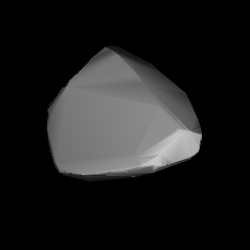Related Research Articles

944 Hidalgo is a centaur and unusual object on an eccentric, cometary-like orbit between the asteroid belt and the outer Solar System, approximately 52 kilometers in diameter. Discovered by German astronomer Walter Baade in 1920, it is the first member of the dynamical class of centaurs ever to be discovered. The dark D-type object has a rotation period of 10.1 hours and likely an elongated shape. It was named after Mexican revolutionary Miguel Hidalgo y Costilla.

237 Coelestina is a typical main belt asteroid.

263 Dresda is a typical Main belt asteroid. It belongs to the Koronis family of asteroids.

343 Ostara is a background asteroid from the inner region of the asteroid belt. It was discovered by German astronomer Max Wolf at the Heidelberg Observatory on 15 November 1892.
945 Barcelona is a minor planet orbiting the Sun in the Asteroid belt. It was discovered 3 February 1921 from Barcelona by the Catalan astronomer Josep Comas i Solà (1868–1937) and named for the city of Barcelona (Spain), the birthplace of the discoverer. It has an estimated diameter of 25.5 km.

534 Nassovia is a minor planet orbiting the Sun. It is a member of the Koronis family of asteroids.

662 Newtonia is a minor planet, specifically an asteroid orbiting mostly in the asteroid belt.
668 Dora is an asteroid orbiting in the asteroid belt located roughly between the orbits of the planets Mars and Jupiter. The name may have been inspired by the asteroid's provisional designation 1908 DO.
864 Aase is an S-type asteroid belonging to the Flora family in the Main Belt.
916 America is a minor planet orbiting the Sun in the main belt between Mars and Jupiter.
947 Monterosa is a minor planet orbiting the Sun.
953 Painleva is a minor planet orbiting the Sun. It was discovered on 29 April 1921 by the Russian astronomer Benjamin Jekhowsky. The planet was named in honor of the French statesman and mathematician Paul Painlevé.
954 Li is a Themistian asteroid.
955 Alstede is a minor planet orbiting the Sun.
963 Iduberga is an S-type asteroid from the asteroid belt's background population. Its rotation period is 3.02 hours.
967 Helionape is an asteroid belonging to the Flora family of Main Belt asteroids. It was discovered by German astronomer Walter Baade at Hamburg Observatory on November 9, 1921, and was named after the Austrian theatrical actor Adolf von Sonnenthal. This object is orbiting the Sun at a distance of 2.23 AU with a period of 3.32 years and an eccentricity of 0.168. The orbital plane is inclined at an angle of 5.4° to the ecliptic.
962 Aslög is a minor planet orbiting the Sun that was discovered by German astronomer Karl Wilhelm Reinmuth on 25 October 1921. Measurements of the lightcurve made in 2010 and 2011 give a rotation period of 5.465 ± 0.01 hours. It has a diameter of 39.5 km (24.5 mi).
5656 Oldfield, provisional designation A920 TA, is a background asteroid from the inner regions of the asteroid belt, approximately 7.7 kilometers in diameter. It was discovered on 8 October 1920, by astronomer Walter Baade at the Bergedorf Observatory in Hamburg, Germany. The asteroid was named for English musician Mike Oldfield.
1921 Pala, provisional designation 1973 SE is a background asteroid in an unstable orbit located in the outer region of asteroid belt, approximately 8.2 kilometers in diameter. It is one of very few bodies located in the 2 : 1 mean motion resonance with Jupiter. It was discovered by Dutch–American astronomer Tom Gehrels at Palomar Observatory on 20 September 1973.
6144 Kondojiro (1994 EQ3) is an asteroid discovered on 14 March 1994 by Kin Endate and Kazuro Watanabe at the Kitami Observatory in eastern Hokkaidō, Japan. It is named after Jiro Kondo, a Japanese Egyptologist and professor of archaeology at Waseda University.
References
- ↑ "966 Muschi (1921 KU)". JPL Small-Body Database . NASA/Jet Propulsion Laboratory . Retrieved 2 May 2016.